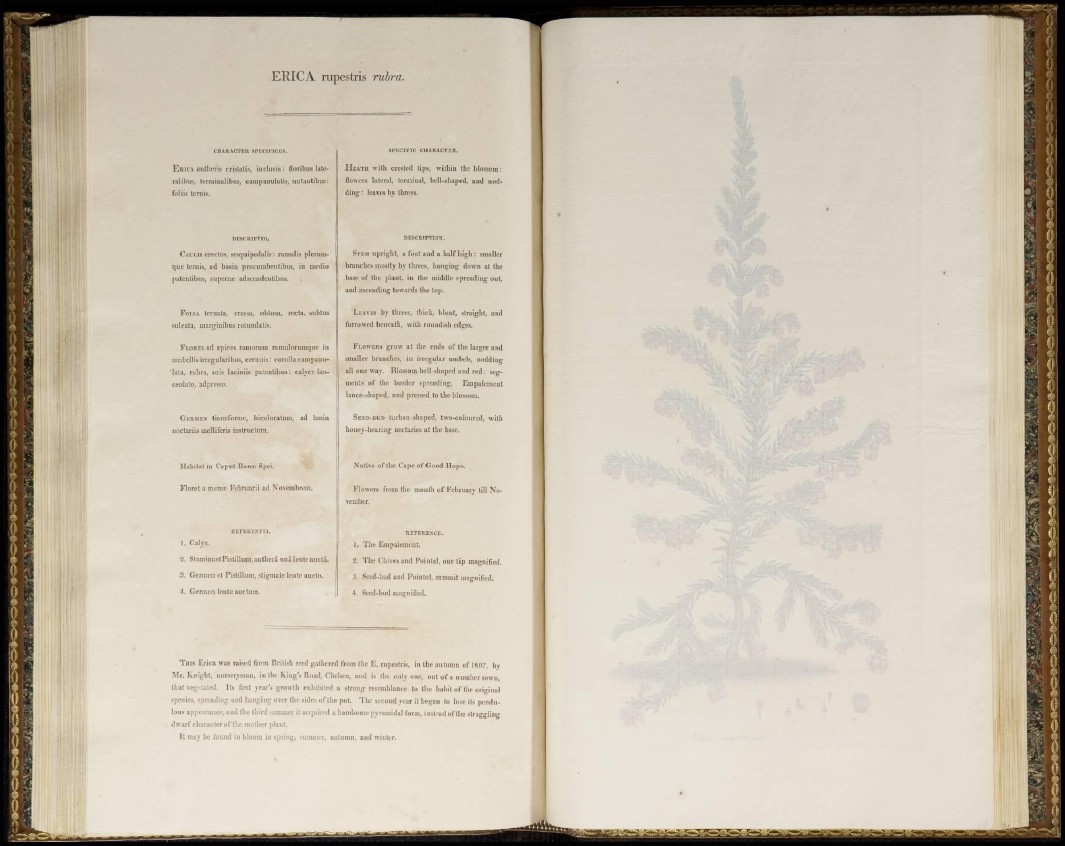
EKICA rupestris rubra.
CHARACTER SPECIFICUS.
ERICA antlicris cristatis, inclusis : floribiis lateralibus,
terminalibus, campanulatis, nutantibus:
foliis ternis.
DESCRIPTIO.
CAULIS erectus, sesqui pedal is: ramulis plcruinque
ternis, ad basin procumbentibus, in medio
patcntibus, supcrnc adscendentibus.
FOLIA ternata, crassa, obtusa, recta, subtiis
sulcata, marginibus rotundatis.
FLORES ad apices ramorum ramulorumque in
umbellis irregularibus, cernuis: corollacampanu-
"lata, rubra, oris Iacinüs patcntibus: calycelaneeolato,
adpresso.
GERMEN tiarrcformc, bicoloratum, ad basin
nectarüs melliferis instructum.
Habitat in Caput Bona; Spei.
Floret a inense Februarii ad Novembrem,
REFEREN TIA.
1. Calyx.
2. StaminaetPistillum, antherâ un alenté anetâ.
3. Germen el Pistilluni, sligmale ¡ente aucto.
4. Germen lente auctum.
SPECIFIC CHARACTER.
HEATH with cresled tips, within the blossom:
flowers lateral, terminal, bell-shaped, and nodding
: leaves by threes.
DESCRIPTION.
STEM upright, a foot and a half high: smaller
branches moslly by three?, hanging down at the
base of the plant, in the middle spreading out,
and ascending towards the top.
LEWES by threes, thick, blunt, straight, and
furrowed bcncalh, with roundish edges.
FLOWERS grow at the ends of the larger and
smaller branches, in irregular umbels, nodding
all one way. Blossom bell shaped and red : segments
of the border spreading. Empalement
lance-shaped, and pressed to the blossom.
SEED-BCD turban-shaped, two-coloured, with
honey-bearing nectaries at the base.
Native of the Cape of Good Hope.
Flowers from the mouth of February till November.
REFERENCE.
1. The Empalement.
3. The Chives and Pointai, one tip magnified.
3. Sccd-bud and Pointai, summit minified.
4. Seed-bud magnified.
THIS Erica was raised from British seed gathered from the E. rupestris, in the autumn of 1807, by
Mr. Knight, nurseryman, in the King's Road, Chelsea, and is the only one, out of a number sown,
that vegetated. Its first year's growth exhibited a strong resemblance to the habit of the original
species, spreading and hanging over the sides of the pot. The second year it began to lose its pendulous
appearance, and the third summer it acquired a handsome pyramidal form, instead of the straggling
dwarf character of the mother plant.
It may be found in bloom in spring, summer, autumn, and winter.